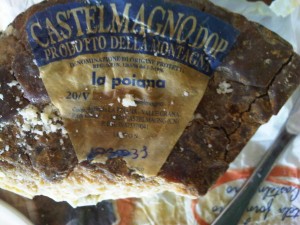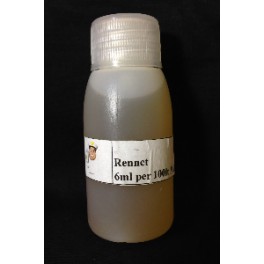Leon
I had Castel Magno today :-)
What is an antibiotic rapid test?
When there is a chance of antibiotic residues passing into milk it is important to be able to test for it quickly, since milk is a highly perishable product, so action is needed quickly. Milk can also not be worked into value added products like, yoghurt or cheese when it contains antibiotics, since the added lactic acid bacteria(LAB) will not grow in the presence of antibiotics. So for the producer of these products it not only limits the possibilities for the raw milk, but in case they miss the presence of the antibiotics, it could mean big losses.
It is thus of vital importance to be able to test for antibiotics as quickly as possible – even before the milk tanker is off loaded at the factory. When antibiotic milk received from one farmer is mixed with the mikl of other producers in the bulk tank, they will hold that farmer responsible for the loss of the entire bulk tank. It is thus in the interest of farmers to make sure that they do not supply antibiotic containing milk. This can easily happen through mis-management on the farm, in the case where a long-acting antibiotic is given in palce of a short acting antibiotic. The cow will be placed back into the milking sequence before all the antibiotic is out of the system and it will contaminate the entire batch.
Twinsensor that could test for tetracyclines and beta-lactames has evolved into the Trisensor.
Trisensor is brought to you by Unisensor Germany and is the latest rapid test that tests for Beta-Lactam, Sulfamides and Tetracycline in milk. This rapid test tests for 3 different families of antibiotics mainly used by farmers to control or prevent animal bacterial diseases.
Due to their human harmfulness and in respect to EU regulations, efficient controls of these antibiotics residues in food and especially in milk are needed.
The Trisensor test kit provides a multiplex dipstick test (Lateral Flow (LF) assay) that uses specific receptors and generic monoclonal antibodies. The results are visualized at the 3 specific capture lines by the use of colloidal gold-conjugates.
In this final version of the test, a fourth reagent line has been added to the dipstick, known as a “dynamic control line”. The intensity signal of this control line will proportionally increase with the sample/reagent flow migration. Therefore it reflects the correct use of the test, excludes potential invalid results and serves also to establish a threshold value limit for each test line result interpretation.
The test takes 6 minutes to run and does not require any cleaning or sample preparation. It is able to detect Limit of Detection(LoD) the 3 antibiotics at concentrations near their respective Maximum Residue Limit (MRL) values.
The results can be interpreted either through direct visual observation of the test and control or for a more “MRL-suitable” observation and result, an optical reader (Readsensor) can be used that suppresses any subjectivity from the operator and doesn’t need any calibration.
What makes this test different from the others is that it tests for Sulfamides. When ingested by humans side effects can include dizziness, drowsiness, nausea, vomiting, difficulty breathing etc. Unfortunately many South African farmers do not test for Sulfamides in milk samples and conform to EU principles regarding Sulfamides.
[audio:Antibiotic.mp3]
What’s cheese cultures all about?
Cheese culture comes in possibly as many varieties as cheese itself. Some cultures are traditional to specific cheese types and cannot or may not be changed, but for the most part we can evaluate a specific method of cheese making and interchange cultures to make it work better in regard to getting more yield, better flavor or a faster process. More yield means that we are getting more kilograms of cheese from the same kilograms of milk. Better flavor can be imparted by more proteolytic and lipolytic cultures. This means that these specific cultures have more enzymes that can break down protein and fat to aromatic and flavor compounds that is characteristic of that cheese variety. When we use fast cultures we usually save on labour as time is money and we should elso get more cheese out, since there is less time for demineralization of the curd.
From the above you can deduct that we can play around with different cultures to optimize a process and I must state that I have never been in a factory where this is not possible and where value could not be added in some way.
When you want to buy cultures it is important to find out which cultures are traditionally used in that cheese type – then have a look at the traditional process and with your cheese making knowledge you can start to make small changes. It is important in the dairy industry or and place where you are experimenting to always change one thing at a time, otherwise you might never know which change made the critical difference.
Cultures can be divided into groups according to the temperatures they work best at like thermophiles are heat loving and operate best between 37-45°C, where mesophiles are more comfortable in room temperatures and operate best at 22-35°C.
Cultures also differ in their handling of stressors in production like heat and salt. Thermophiles are usually much more sensitive to salt, so remember that it is much better to use them when salting cheese lightly and slowly in a brine solution. If you were to use the dry salting process that is traditionally used with cheddar they will be stopped in their tracks and no more or very little lactic acid will be formed after that. So if changing to a predominant mix of thermophiles in a dry salting process you must get them much closer to your final pH, as they will stop quite fast. Mesophiles are much more tolerant of salt and will continue to acidify in the same conditions.
Cheese making cultures in South Africa are usually very traditional – it is only now that people are starting to experiment with different combinations, without changing the general characteristic of a cheese variety too much to make it unrecognizable, but enough to make it different from all the rest.
Suppliers of cheese cultures in South Africa, and surely the rest of the world are picking up on these changing needs and are innovating new mixes to accommodate the cheese makers.
Dairy culture companies are thus becoming part of a rapidly changing dairy industry.
Rennet more about it – a lot more :-)
Rennet is used in the production of cheese as a milk curdling enzyme.
It converts milk casein (protein) from a soluble to an insoluble material and during this process; the rennet separates the milk into solids (curds) and liquid (whey).
The different milk coagulation systems available is natural animal rennet rennet from GMO organisms, coagulating enzymes from plant origin and coagulating enzymes from non-GMO microbial origin.
Animal is the best, but a lot of people prefer not to use it, because of religious views. The closest product is rennet from GMO origin, since chemically it is just like that of natural, animal origin, but here we also have a protesting fraction of people, because they believe this type of product will harm them in some way. They thus do not perceive this as “natural”.
Plant coagulation enzymes are not used commercially, since they are very hard to standardize and usually have a lot of side reactions that can cause off-tastes and other problems in cheese.
Microbial rennet of non-GMO origin has vastly improved and now has very few side- reactions. This rennet is used in large amounts in the world, since it is classified as Halal, Kosher and vegetarian. Technically these are not rennet, but milk coagulating enzyme. Different organisms are used to produce non-GMO microbial rennet.
Microbial rennet is a food grade enzyme system produced by the controlled fermentation for non-genetically modified Rhizomucor miehei . It contains the specific protease activity that makes it effective as a milk clotting enzyme. The rennet have been specially treated to make the enzyme thermal labile sensitive to inactivation by heat at pasteurization temperatures. Rennet can be bought in tablets and as liquid or paste.
As the economical alternative to cloned/ calf rennet, microbial rennet liquid has the same uses, process conditions and clotting time.
When buying rennet, certain characteristics need to be taken into account. This will include activity of 1:50,000 MCU/ml, form which should be a dark brown liquid, solubility (miscible with water), odorless and a specific gravity of approximately 1.14g/ml.
Rennet requires the availability of calcium ions for activity. Calcium, added as calcium chloride should be in the range of 10 to 100 grams per 100 litres of milk for optimum performance. The effect of calcium chloride concentrates on the activity of various enzyme samples and is superior to animal rennet.
Enzyme use levels are generally dictated by processing conditions, milk composition and calcium chloride concentration. In a general a rate of one half that of regular strength calf rennet can be used, but laboratory or pilot scale tests should be run to optimize dose levels.
Effective working temperature range plays a big role in performance. Calf rennet has a much narrower range of optimum working than most of the new “rennet” systems.
Due to it’s thermal labile nature, extra care should be taken when storing rennet; therefore it should be stored in sealed containers under refrigerated (4?C to 8?C) to minimize the loss of activity.
When using rennet to coagulate milk, always make sure to check the specification sheet of the product that you plan to use, to make sure that you are using it in the rifgt way to get the most out of that specific product.
http://cheesemaking.co.za/shop/10-rennet-south-africa
Leon the Milkman
Dairy and Cheese Consultant
Cape Town, South Africa
http://cheesemaking.co.za/shop/cheese-consultancy/25-cheese-consultant.html
Interesting culture post
http://referral.experts.za.net/cheddar-cheese-culture/
Enjoy this info, dairy fans!
Regards,
Leon the Milkman
Need Cheese Consultants?
If you are a commercial cheese maker and need help:
Go have a look at www.cheeseconsultants.com
Regards,
Leon the Milkman
Sacco is Halal Certified!
My favourite culture company in the world has become Halal Certified! Jeyyy for them!!
Especially to QA Emiliano Ambrosini!!
Regards,
Leon the Milkman
Man o’ Mozarella
Leonard Majampa showing how mozzarella should stretch when using the right cultures and process.
Aaahhh, job satisfaction!!!
Leonard is from RFG Porto Bello, in South Africa and will be going with four other cheese makers to France in September 2010 for 3 weeks of advanced training.
Rennet types – know them all
Hi, Milk Fans
The different types of “rennet” or milk coagulation enzymes are:
- from animal origin
- from GMO micro-organisms
- Curdling enzymes from plants
- Curdling enzymes from Non-GMO micro-organisms
Animal origin is the “mother” of rennets giving the highest yield and best taste.
Microbial rennet from GMO micro-organisms has the same chemical composition as animal, with some side reactions, but very close. The comparison is basically like artificial vitamin C and natural vitamin C.
The curdling enzymes from plants like, figs, papaya, etc. are suitable for lacto-vegetarians.
Curdling enzymes from Non-GMO organisms are generally, Kosher, Halaal, vegetarian.
South Africa
http://cheesemaking.co.za/shop/10-rennet-south-africa
Leon the Milkman
Dairy and Cheese Consultant
Cape Town, South Africa
http://cheesemaking.co.za/shop/cheese-consultancy/25-cheese-consultant.html
Sacco Cheese and Yoghurt Cultures
Clerici-Sacco started out as Caglificio Clerici, a privately owned company manufacturing enzymes for cheese production and was originally established in 1872.
In 1984 the Italian company decided to broaden its product range and markets by purchasing Sacco and creating the Clerici-Sacco Group which is still owned by the founder’s descendants.
Thus Sacco cultures bring a long heritage of cheese production with generations of expertise to the South African Market.
An extensive list of cultures for the dairy and meat markets are available from Sacco, and specifications can be viewed on their website at saccosystem.com under products.
Some of the cheeses that are made from their cultures are Sweet Milk Cheeses like Gouda, Edam, Danbo – Hard Cheeses like Parmesan, Pecorino, Gruyere – Pasta Filata Types like Mozzarella, Provolone and Soft Cheeses like Camembert and Brie.
Many South African Champion cheese makers have found these real Italian Cultures to be superior in every category and have won awards with them.


